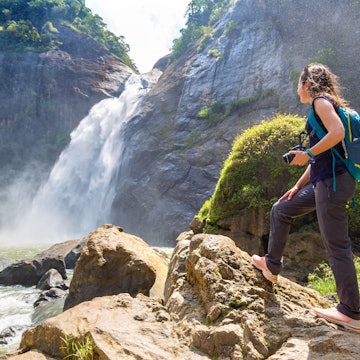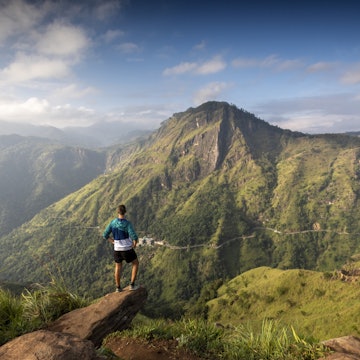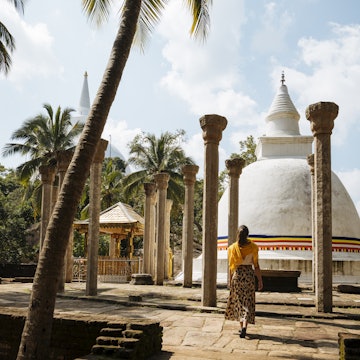
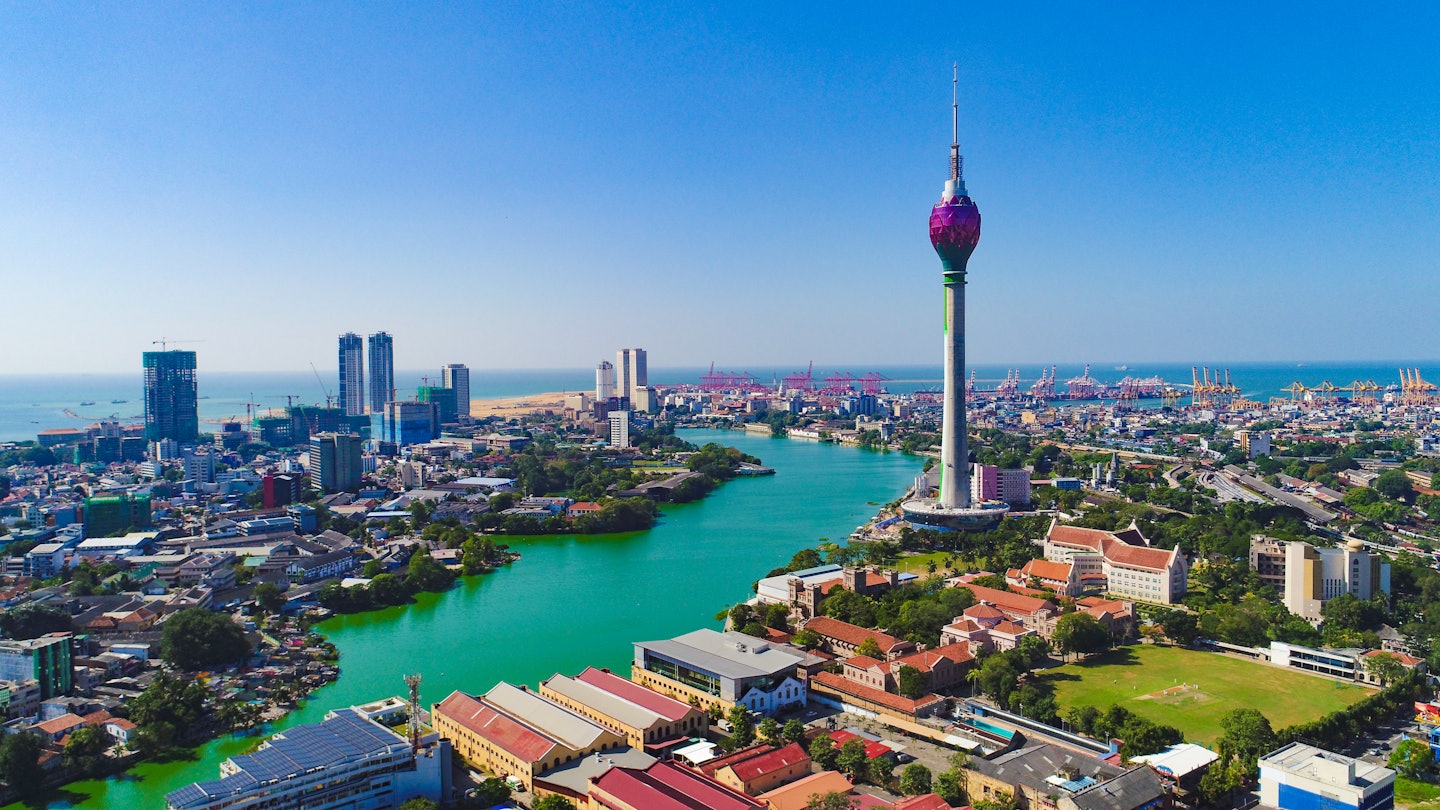
Colombo charms visitors with history, cuisine and sights. Shakeel Sha/Getty Images
Sri Lanka is on everyone’s radar now, and it's easy to see why: coastal surfing villages, hill country train rides, jungle safaris with herds of playful elephants, and even a newly-launched, 300 km-long (186 mile) walking trail through the tea gardens. From its coast to the high mountains, it’s no secret that Sri Lanka easily charms the heart of every visitor. What’s missing from most of these itineraries, however, is Colombo, Sri Lanka’s vibrant, eclectic capital.
Of course, everyone should absolutely travel around the island, but Colombo is only a short 40-minute drive from the country’s main international airport. And it offers an entry into Sri Lanka's history and the way of life through a series of museums, galleries and places of worship. All of this is accompanied by world-class dining, heritage boutique hotels and bustling markets.
Here’s our list of the best things to do in Colombo.
1. Take it all in at the Dutch Hospital
The terracotta-tiled long corridors and breezy, open courtyards of the Dutch Hospital are a thriving, buzzing part of Colombo's life. Grab a sundowner and settle at one of the stone picnic tables to soak up the atmosphere, especially during the weekends when the restaurants, bars and hotels in the neighborhood host live music sessions and DJ nights. Long ago in the 1600s, the complex was first built by the Dutch colonial rulers and added to the Colombo Fort as a hospital to serve officers of the Dutch East India Company. Following Sri Lanka’s independence from the British in 1948, the building took on new roles as an apothecary and a police station before it was turned into the shopping and dining precinct it is today.
Local tip: Dutch Hospital is now home to some of Colombo’s most celebrated restaurants, like the Ministry of Crab serving jumbo-sized lagoon crabs.
2. Dive into Sri Lanka’s history at the Colombo National Museum
With a rich history that spans over 2000 years, Sri Lanka has seen the rise and fall of ancient Buddhist kingdoms, South Indian dynasties and European powers. There's no better place to explore this nuanced past than the Colombo National Museum, housed inside an iconic white building. It can get hot inside in the afternoons, but a visit here is quite fascinating, especially if you are a history buff. Think: Rooms packed with replicas of ancient rock paintings, brass sculptures, stone carvings and Buddha statues; swords and guns in glass cabinets; antique masks that depict demons and other supernatural characters in local folklore; and glided thrones of royal kings.
Planning tip: It’s open until 5pm, and although fan-cooled, the humidity is often uncomfortable. Get in early when the museum opens at 9am.

3. Get lost in the chaos of Pettah Market
You’ll either love or hate Pettah and there’s no in-between. But that’s exactly where Pettah’s charm lies. Crammed inch by inch with seemingly everything under the sun (we are talking stuffed toys, fluorescent wigs, bridal gowns, beach slippers, mirrors of all sizes and Rolex knockoffs), Pettah is Colombo’s biggest and busiest marketplace. It’s a frenzy of activity spread across a maze of crisscrossing lanes and bylanes, each dedicated to a particular trade, like gold jewelry, electronics and fresh vegetables. Come early and get ready to walk through the streets teeming with locals bargaining for clothes, porters carrying towering loads on their backs and street carts selling achcharu, spicy pickled fruit.
Local tip: No visit to Pettah is complete without lunch at Mayura Hotel serving Tamil Sri Lankan meals on banana leaves. Get the crab curry, and then walk to the Bombay Sweets on 1st Cross Street for a glass of falooda, a sweet milky drink made of basil seeds and rose syrup, topped with ice cream and nuts.
4. Marvel at the Jami-Ul-Alfar Mosque
While you are exploring the market in Pettah, don’t miss the Jami-Ul-Alfar Mosque. Located in the center of the market on 2nd Cross Street, this historic landmark is quite unmissable, mostly because of its stunning red-and-white brickwork design that sets it apart from other mosques across the country, giving it the name "The Red Mosque." Built during the early 20th century by Colombo’s Indian Muslim community, the mosque resembles a mix of Indo-Islamic and neoclassical architectural styles. Remember to dress modestly, and carry a scarf to cover up. Avoid prayer times, especially on Friday afternoons.
Detour: A five-minute walk south from the mosque, you'll find the iconic Khan Clock Tower on the roundabout, built by a Parsi business family from Mumbai who settled down in Colombo.
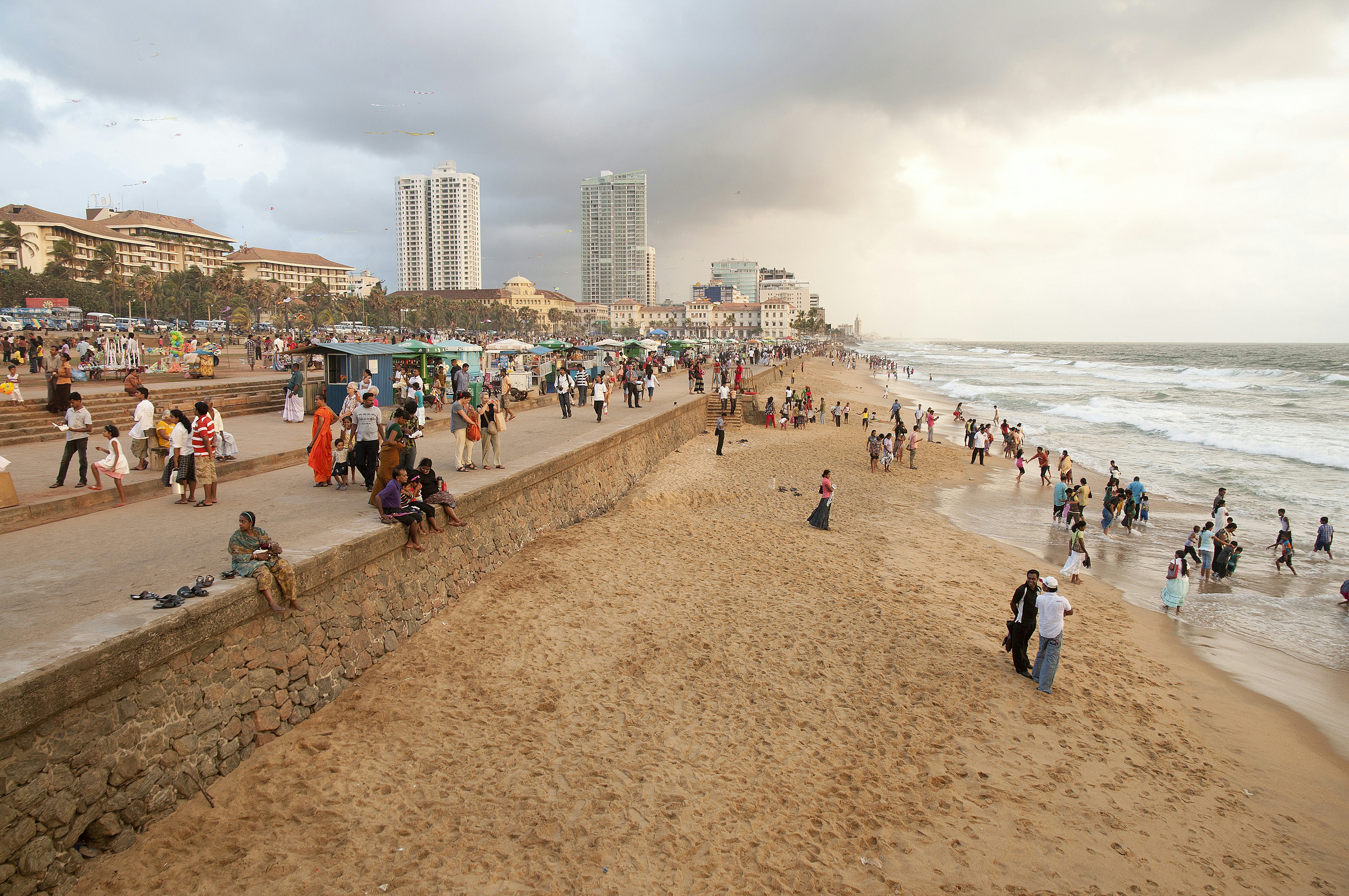
5. Watch people and sunsets at Galle Face Green
The heart of Colombo’s business district is constantly changing. Today, Galle Face Green, Colombo’s atmospheric beachfront park, surrounds a series of luxury hotels, shopping malls and the Colombo Port City, a fancy, commercial expansion with high risers still under construction. But all this has not deterred Colombo residents from reclaiming their favorite weekend hangout spot. Some of Galle Face’s iconic street food stalls are now only reduced to a memory, but this breezy, 500m-long promenade springs to life every evening when couples, friends and families gather for a picnic or post-dinner ice cream.
Local tip: The soul of Galle Face Green is its people, so head there on the weekend to see the place packed with local families and hawkers. It’s also a popular kite-flying spot, particularly in the breezy months of June and July.
6. Tour the Number 11
The late Geoffrey Bawa is Sri Lanka’s most renowned architect. Bawa built spaces that seamlessly merged with the island’s tropical climate, and his work is spectacular. To get a feel of his style, book a guided tour at Number 11, Bawa’s former urban residence. When you walk through this charming home, you’ll see garage doors designed with timber latticework, light wells, courtyard gardens with frangipani trees, long corridors, and wall-sized paintings sourced from Bali inside the guest suite. If you are into art and design, it’s also worth booking a night at the house.
Detour: If you love this, head to Bawa’s country estate Lunuganga, a two-hour drive south of Colombo.
7. Shop sustainably at the Good Market
If you are in town on a Saturday, you cannot, quite truly, miss the Good Market, which takes place next to the Race Course Ground in Cinnamon Gardens, a leafy, upscale neighborhood of the city. You’ll find patchwork bags, knitted tops, potted cacti, handmade jewelry, rattan furniture and organically grown spices. If you need to grab lunch, a piece of cheesecake or a refreshing cooler, the vendors at the Good Market have you covered. One more thing: if you miss the Saturday marketplace, the Good Market’s boutique and cafe is just around the corner and sells a selection of sustainable, locally produced items.
Local tip: Come around 10am for breakfast staples like idi appa or idiyappam (steamed rice flour mats), and kuzhi paniyaram (pan fried rice and lentil dumplings).
8. Make your way to the St. Anthony's Shrine
The history of the St. Anthony’s Shrine in Colombo runs deep, as it’s built on a site that was once home to a mudbrick chapel in the 18th century. Often synonymous with locals of all faiths as the “Church of Miracles,” it was one of the sites of the deadly Easter bombings in 2019. But this Roman Catholic church opened to the public soon after, and you’ll now find locals returning for daily prayers and offerings. Look out for the intricate statues, stained-glass windows and a mix of neoclassical and Gothic architectural styles.
Detour: Walk south for about 10 minutes to reach the 18th-century Dutch-built Wolvendaal Church, also known as the Christian Reformed Church.

9. Join the devotees at Gangaramaya Temple
Dating back to the 19th century, the Gangaramaya Temple is a key spot for most travelers. It's also a place of worship for Sri Lankan Buddhists who come here with white and pink lotuses, incense, and oil lamps as offerings to the Buddha. The temple's design is a mix of Sri Lankan, Chinese, Thai, and Burmese, with gilded Buddha images, nymph statues, and pastel drawings of Buddha’s previous lives. The main temple door depicts ornate wood carvings of elephants and swans. What’s most fascinating though is the museum, a treasure trove of artifacts and antique collectibles from across the world. There is a seemingly uncountable collection of Buddha statues, divine images, old watches, sheeny trinkets, old coins, and the world’s smallest Buddha encased in a glass cabinet, which you can only see with a magnifying glass.
Local tip: As elsewhere across Sri Lanka, cover your shoulders and knees before entering a Buddhist temple, and remove your footwear and hats.
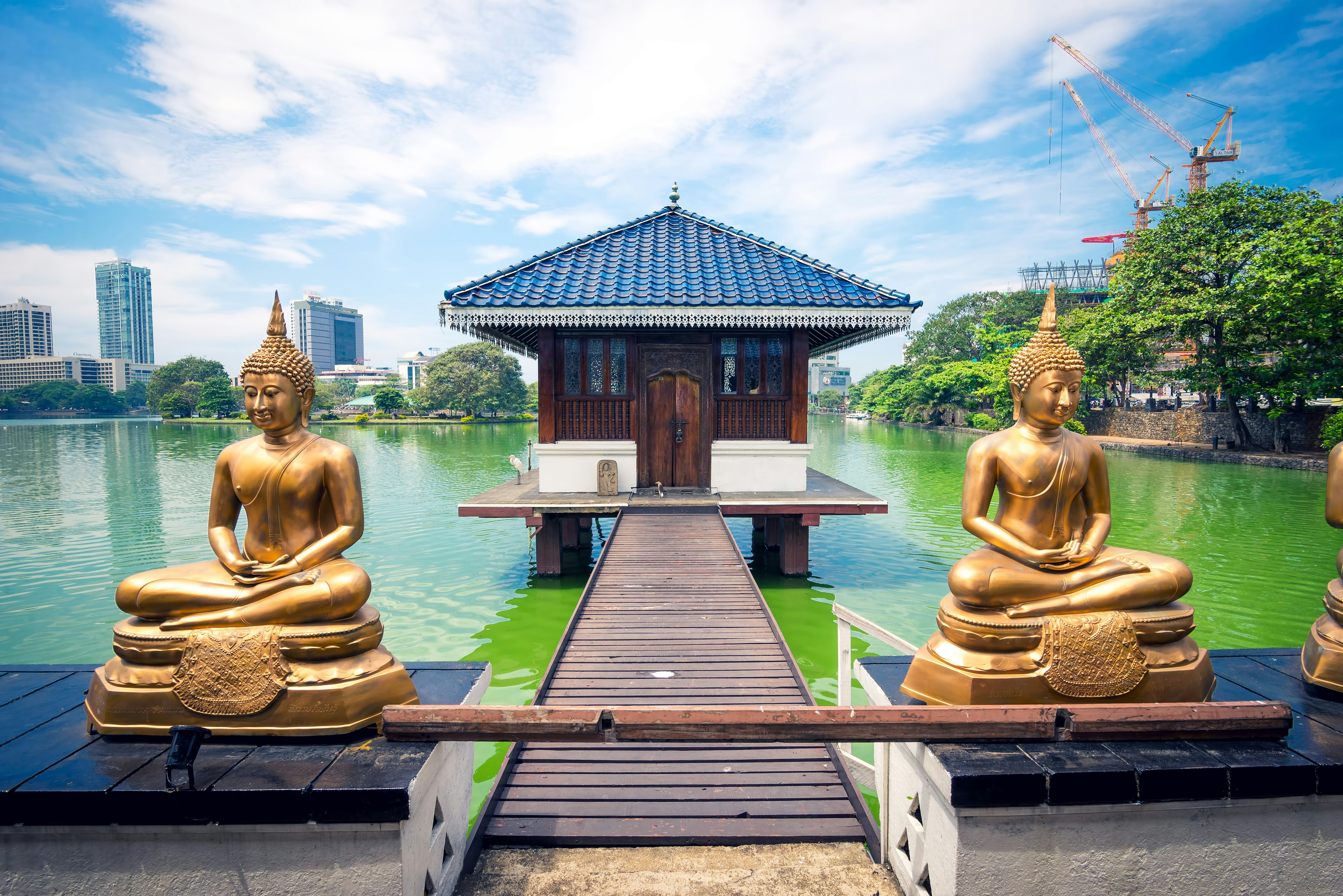
10. Visit the Seema Malaka
From Gangaramaya, make your way back to the main road hugging the Beira Lake for a visit to Seema Malaka, the captivating meditation pavilion on the lake’s waters. Designed by the late Geoffrey Bawa, it’s an excellent place to see how Bawa incorporated his design principles into public spaces. The pavilions here house bronze-toned Buddha images and a Bodhi tree (a sacred fig tree under which Buddha achieved enlightenment).
Local tip: It’s particularly striking at night with bright, illuminated lights reflecting on the lake.
11. Eat excellent Sri Lankan food
The Sri Lankan capital is a microcosm of the island itself. It’s a brilliant lead-in to Sri Lanka with traditions, rituals and cuisines of the island's different ethnic and religious groups, all packed into one place. So when you are here, make sure to eat Sri Lanka's very best local food.
Start at the Tamil-run Saraswati Lodge for South Indian-style dosa (thin, crispy crepes made of fermented rice and lentil batter) breakfast. Come lunch, head to the VOC Cafe for lamprais, a Dutch-Burgher meal of rice and mixed meat tightly assembled in a banana leaf, and end your day with a fancy appa or appam (bowl-shaped pancakes) dinner at the Palmyrah Restaurant. For snacks, explore the city’s short-eats culture at the Green Cabin, one of Colombo’s oldest bakeries.
Local tip: If you’ve got more time in hand, dine at Amma Nisa for biryani cooked by Sri Lankan Moors. And don’t miss the watalappan. It’s a creamy, soft custard made of coconut milk, eggs, and jaggery, topped with cashews for a delightful crunch.
12. Go for the views at Colombo Lotus Tower
Some locals believe that the 350m-tall Colombo Lotus Tower, funded by China, with an illuminated lotus-shaped throne doesn’t add value to the city. Others think that Colombo needs a unique landmark that elevates the city to celebratory status. Either way, it’s Colombo’s tallest skyscraper, and now part of the city's evolving skyline from everywhere we look. And most residents have now come to embrace it, sometimes throwing office dinners at the restaurant on top. You’ll also see sprawling views from the observation deck.
Detour: From here, don’t miss the chance to walk to the nearby secondhand bookshops on McCallum Road. If you love books, expect to spend a few hours. The shop owners are chatty and helpful, too.
13. Walk around the Independence Square
The Independence Memorial Hall remains one of Colombo’s important landmarks, and there’s a reason; it was built to commemorate Sri Lanka’s independence from the British. A stone building with intricate columns and statues of lions, the site derives its design from the Audience Hall in Kandy. Extending south of the building is the Independence Walk and the Independence Square Park frequented by walkers, joggers and runners every morning and evening.
Local tip: The nearby Bauddhaloka Mawatha is one of the city’s most pedestrian-friendly roads, as massive towering trees here provide shade even on balmy days.
14. Explore contemporary talent at the Museum of Modern and Contemporary Art
Located inside the glitzy Crescat Boulevard shopping mall next to the Cinnamon Grand Hotel, the Museum of Modern and Contemporary Art (MMCA) is an excellent place to seek out art-led experiences with rotating exhibitions, gallery talks and lectures.
It’s not just another modern gallery that displays the work of local artists but a platform that also educates, researches and preserves different mediums of art across the country. One of their recent exhibitions explored how land has been used and transformed in Sri Lanka over the last few decades, so this is the kind of place you’ll come to gain a deeper understanding of the island.
Planning tip: Check out their Instagram for updates on new displays, tours and experiences.
15. Enjoy Colombo’s cafe culture
Colombo’s home to chic, cutesy cafes. Enjoy a cup of coffee on the oceanfront, go for a leisurely brunch, get some work done or relax with a book at leafy corners. It’s also a great way to tap into the city’s contemporary coffee, drinks and dining scene as more and more homegrown baristas, chefs and entrepreneurs come together to spotlight the island’s local produce in fresh, exciting ways.
Local tip: For brunch, nothing beats The ‘Stache; order the Siam Ceylon, which is Sri Lankan-style rice cooked in coconut milk paired with Thai red curry.
16. Watch a stage drama at the Lionel Wendt Centre
Lionel Wendt wore many hats; he was a barrister, pianist, photographer, filmmaker and critic. He was also one of the pioneers of the ‘43 Group, a 20th-century modern art collective established in Sri Lanka. Wendt's former residence was turned into the Lionel Wendt Centre in his memory and consists of spaces for art exhibitions and a theater for concerts, stage plays and dance performances. Today, it remains a key platform for everything art-centric in Colombo.
Local tip: To know more about the ‘43 Group, head to Sapumal Foundation, a gallery displaying the work of the collective.










